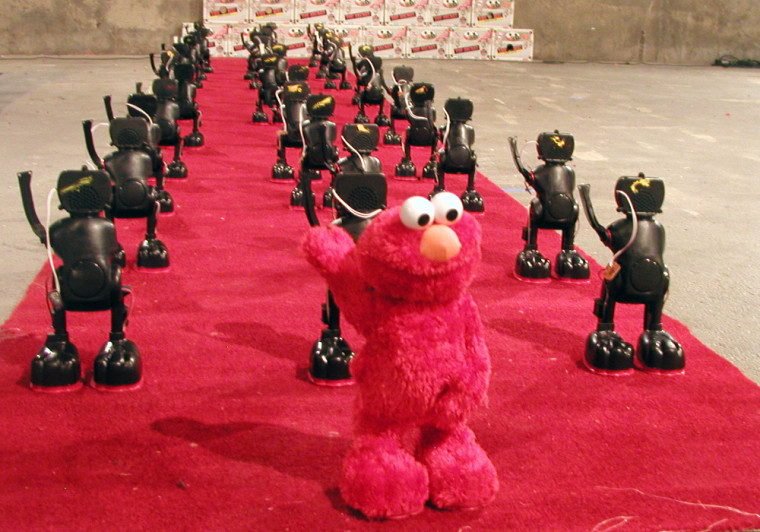Twelve years ago, a mechanized version of a red plushy “Sesame Street” co-star became the unofficial face of obnoxious Christmas consumerism. Retailing for $28.99, “Tickle Me Elmo” resold for as much as $1,500 to both collectors and parents desperate to get the giggling, vibrating ‘It Toy’ of the season into the grasping hands of their commercial-addled children.
Now, as 2008 draws to a close, updated versions of the walking, talking Elmo toy still top letters to Santa, though shoppers aren’t nearly as apoplectic over obtaining the new $60 TMX Elmo (short for “Tickle Me Extreme”). But at Manhattan’s art and technology center, 30 or so of last season’s less expensive Elmos are doing something different for the holidays.
Repurposed, reprogrammed and removed of their skin, they now move in unison in a project by resident artist Adrianne Wortzel, depicting Napoleon’s misguided march into the Egyptian desert in the demonstration, “”
The project came to fruition on Saturday, Dec. 13, at Eyebeam’s annual , an all-day, all ages, multi-workshop electronic craft-making fair. The event started as a means to engage the community with Eyebeam and its working artists. The “kitschy atmosphere of creativity,” as the event cofounder Liz Slagus describes it, continued to grow alongside the DIY (Do It Yourself) aesthetic. Now, with things as they are, Holiday Hackshop is gaining relevance beyond the Eyebeam mixer.
“This is where the economy and the awareness of the environmental crisis comes in,” says Slagus, who also Eyebeam’s Director of Education and Public Programs. “People are slowly beginning to realize what being a ‘passive consumer’ means. (When you buy something) you’re not necessarily getting something better and you’re not doing the environment, and in many cases human rights and Third World countries, a favor by continuing to fall prey to consumer advertising.”
While the Elmo project worked mostly as a demonstration, around 500 participants had the opportunity to take part in other workshops. For various supply fees, they could build a snow globe or musical instrument from recycled toys and other junk, outfit his or her own bike with retro reflective safety tape or hack iPods — broken or not — to discover new purposes for the ubiquitous gadget.
In that “Frankenstein Your iPod” workshop, participants learned how easy it is to crack open even a broken iPod, install new software, or even turn the iPod into a musical instrument.
The instructor, resident artist Hans-Christoph Steiner, also founded Eyebeam’s that serves the same purpose, “to inspire people to reuse and reinvent the PDAs, iPods and mobile phones that they already have, instead of generating even more electronic waste,” Steiner says.
Not that you should get the idea that Holiday Hackshop is a somber meditation on the evils of what you’re buying. , there is plenty of cheer, eggnog and holiday tunes served up, and you don’t even need to be crafty or handy to join in. “The day is programmed to cater to a pretty wide range of skill sets,” says Slagus. “
“Holiday Hackshop is meant to make accessible the work and themes the Eyebeam residents and fellows are tackling,” Slagus adds. “We do that with fun and engaging projects, extra assistants to make sure no one gets lost, and a fun atmosphere — music, candy and lights help. This allows everyone to relax and enjoy as they learn and create.”
And the Elmo thing? The hacking demonstration isn’t so much about consumerism as a commentary on America’s military effort in Iraq as compared to Napoleon’s ill-advised Egypt mission.
If that’s too History Channel for your liking, think of it as an art project that “explores and uses sensor and wireless communication to create clusters of entities moving in exact synchronization in response to a call to arms,” as Wortzel describes on her Web site.
If that’s too Discovery Channel for you, just know it looks really cool (albeit kind of sinister) and on Wortzel’s Web site. Why use Elmos? “They do something that artificial intelligence laboratories haven’t been able to figure out,” Wortzel says of the primitive robots. “They stand up, fall down and stand up again straight out of the box.” All the better to “learn” a tandem routine, configured by Wortzel with the help of a choreographer.
Coincidentally, Wortzel did have difficulty finding enough Elmos for the project. The only $30 “last season” Elmos she could dig up (after Fisher Price replaced them with the $60 version for the holidays) all spoke French (that is, before Wortzel’s team removed their voice boxes).
On the day of Holiday Hackshop, Wortzel and her team worked as an assembly line hacking 30 Elmos, removing the furry skin and replacing the motherboards in preparation for their synchronized performance at the end of the day. (One removed skin serves as the star on the Eyebeam Christmas tree.)
As they worked, the Elmo team discussed the process with onlookers. While it wasn’t as hands-on as the “Extreme Weather Snow Globe” or “Frankenstein Your iPod” workshops, there was plenty to pick up, even for the younger viewers.
“One little girl wanted to learn electronics,” says Wortzel. “And she did.”
